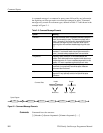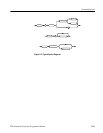
Command Syntax
TDS Family Oscilloscope Programmer Manual
2–9
"this is a valid string"
3. You can mix quotation marks within a string as long as you follow the
previous rule:
"this is an 'acceptable' string"
4. You can include a quote character within a string simply by repeating the
quote. For example,
"here is a "" mark"
5. Strings can have upper or lower case characters.
6. If you use a GPIB network, you cannot terminate a quoted string with the
END message before the closing delimiter.
7. A carriage return or line feed imbedded in a quoted string does not terminate
the string, but is treated as just another character in the string.
8. The maximum length of a quoted string returned from a query is 1000
characters.
Here are some invalid strings:
H "Invalid string argument'
(quotes are not of the same type)
H "test<EOI>"
(termination character is embedded in the string)
Several digitizing oscilloscope commands use a block argument form:
Symbol Meaning
<NZDig> A nonzero digit character, in the range 1–9
<Dig> A digit character, in the range 0–9
<DChar> A character with the hex equivalent of 00 through FF
hexadecimal (0 through 255 decimal)
<Block> A block of data bytes, defined as:
<Block> ::=
{ #<NZDig><Dig>[<Dig>...][<DChar>...]
| #0[<DChar>...]<terminator> }
<NZDig> specifies the number of <Dig> elements that follow. Taken together, the
<Dig> elements form a decimal integer that specifies how many <DChar>
elements follow.
Block Arguments


















